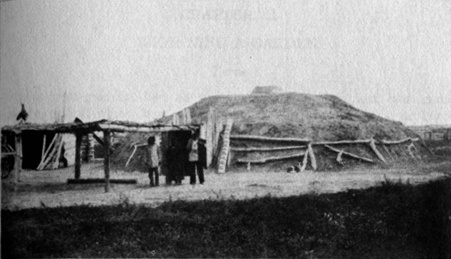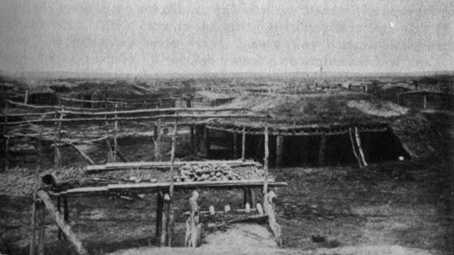"Chapter I" by Maxi'diwiac (Buffalo Bird Woman) of the Hidatsa Indian Tribe (ca.1839-1932)
From: Buffalo Bird Woman's Garden
Recounted by Maxi'diwiac (Buffalo Bird Woman) of the Hidatsa Indian Tribe (ca.1839-1932)
Originally published as Agriculture of the Hidatsa Indians: An Indian Interpretation by Gilbert Livingstone Wilson (1868-1930). Minneapolis: University of Minnesota, 1917. (Ph. D. Thesis).
We Hidatsas believe that our tribe once lived under the waters of Devils Lake. Some hunters discovered the root of a vine growing downward; and climbing it, they found themselves on the surface of the earth. Others followed them, until half the tribe had escaped; but the vine broke under the weight of a pregnant woman, leaving the rest prisoners. A part of our tribe are therefore still beneath the lake.
My father, Small Ankle, going, when a young man, on a war party, visited Devils Lake. "Beneath the waves," he said, "I heard a faint drumming, as of drums in a big dance." This story is true; for Sioux, who now live at Devils Lake, have also heard this drumming.
Those of my people who escaped from the lake built villages near by. These were of earth lodges, such as my tribe built until very recent years; two such earth lodges are still standing on this reservation.
The site where an earth lodge has stood is marked by an earthen ring, rising about what was once the hard trampled floor. There are many such earthen rings on the shores of Devils Lake, showing that, as tradition says, our villages stood there. There were three of these villages, my father said, who several times visited the sites.
Near their villages, the people made gardens; and in these they planted ground beans and wild potatoes, from seed brought with them from their home under the water. These vegetables we do not cultivate now; but we do gather them in the fall, in the woods along the Missouri where they grow wild. They are good eating.
These gardens by Devils Lake I think must have been rather small. I know that in later times, whenever my tribe removed up the Missouri to build a new village, our fields the first year, were quite small; for clearing the wooded bottom land was hard work. A family usually added to their clearing each year, until their garden was as large as they cared to cultivate.
As yet, my people knew nothing of corn or squashes. One day a war party, I think of ten men, wandered west to the Missouri River. They saw on the other side a village of earth lodges like their own. It was a village of the Mandans. The villagers saw the Hidatsas, but like them, feared to cross over, lest the strangers prove to be enemies.
It was autumn, and the Missouri River was running low so that an arrow could be shot from shore to shore. The Mandans parched some ears of ripe corn with the grain on the cob; they broke the ears in pieces, thrust the pieces on the points of arrows, and shot them across the river. "Eat!" they said, whether by voice or signs, I do not know. The word for "eat" is the same in the Hidatsa and Mandan languages.
The warriors ate of the parched corn, and liked it. They returned to their village and said, "We have found a people living by the Missouri River who have a strange kind of grain, which we ate and found good!" The tribe was not much interested and made no effort to seek the Mandans, fearing, besides, that they might not be friendly.
However, a few years after, a war party of the Hidatsas crossed the Missouri and visited the Mandans at their village near Bird Beak Hill. The Mandan chief took an ear of yellow corn, broke it in two, and gave half to the Hidatsas. This half-ear the Hidatsas took home, for seed; and soon every family was planting yellow corn.
I think that seed of other varieties of corn, and of beans, squashes, and sunflowers, were gotten of the Mandans 1 afterwards; but there is no story telling of this, that I know.
I do not know when my people stopped planting ground beans and wild potatoes; but ground beans are hard to dig, and the people, anyway, liked the new kind of beans better.
Whether the ground beans and wild potatoes of the Missouri bottoms are descended from the seed planted by the villagers at Devils Lake, I do not know.
My tribe, as our old men tell us, after they got corn, abandoned their villages at Devils Lake, and joined the Mandans near the mouth of the Heart River. The Mandans helped them build new villages here, near their own. I think this was hundreds of years ago.
Firewood growing scarce, the two tribes removed up the Missouri to the mouth of the Knife River, where they built the Five Villages, as they called them. Smallpox was brought to my people here, by traders. In a single year, more than half my tribe died, and of the Mandans, even more.
Those who survived removed up the Missouri and built a village at Like-a-fishhook bend, where they lived together, Hidatsas and Mandans, as one tribe. This village we Hidatsas called Mu'a-idu'skupe-hi'cec, or Like-a-fishhook village, after the bend on which it stood; but white men called it Fort Berthold, from a trading post that was there.
We lived in Like-a-fishhook village about forty years, or until 1885, when the government began to place families on allotments.
The agriculture of the Hidatsas, as I now describe it, I saw practiced in the gardens of Like-a-fishhook village, in my girlhood, before my tribe owned plows.

An earth lodge
Note ladder at right of lodge entrance. Drying stage before entrance lacks the usual railings.
(Photograph by courtesy of Rev. George Curtis.)

Like-a-fishhook village in process of being dismantled (about 1885)
Drying stage in foreground is floored Arikara fashion with a mat of willows. The Arikaras at this time had joined the Hidatsa-Mandans.
(Photograph by courtesy of Rev. George Curtis.)
1 "In the garden vegetable family are five; corn, beans, squashes, sunflowers, and tobacco. The seeds of all these plants were brought up from beneath the ground by the Mandan people.
"Now the corn, as we believe, has an enemy–the sun who tries to burn the corn. But at night, when the sun has gone down, the corn has magic power. It is the corn that brings the night moistures–the early morning mist and fog, and the dew–as you can see yourself in the morning from the water dripping from the corn leaves. Thus the corn grows and keeps on until it is ripe.
"The sun may scorch the corn and try hard to dry it up, but the corn takes care of itself, bringing the moistures that make the corn, and also the beans, sunflowers, squashes, and tobacco grow.
"The corn possesses all this magic power.
"When you white people met our Mandan people we gave to the whites the name Maci', or Waci', meaning nice people, or pretty people. We called them by this name because they had white faces and wore fine clothes. We said also 'We will call these people our friends!' And from that time to this we have never made war on white men.
"Our Mandan corn must now be all over the world, for we gave the white men our seeds. And so it seems we Mandans have helped every people. But the seed of our varieties of corn were originally ours.
"We know that white men must also have had corn seed, for their corn is different from ours. But all we older folk can tell our native corn from that of white men."–WOUNDED FACE (Mandan)
[Next]